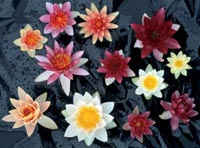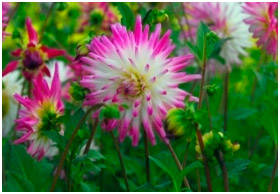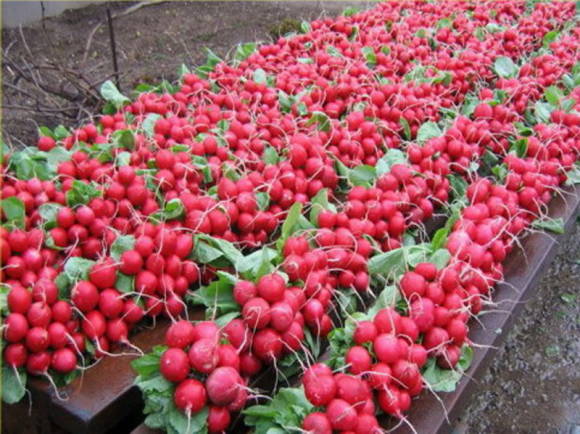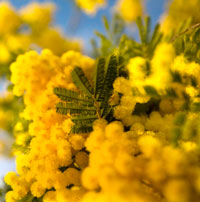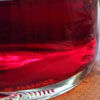Canary date (Phoenix canariensis) from the arec family (Arecaceae) is endemic to the Canary Islands, where it grows in arid rocky and rocky places.
In nature, this palm tree can reach 15-20 m, and some specimens grow up to 40 meters in height. The trunk is single, dark brown, with diamond-shaped scars from fallen leaves, its diameter can be 60-120 cm with a thickening in the lower part. The powerful crown at the top of the trunk consists of 150-200 feathery grayish-green leaves, each of which reaches 4-6 meters in length. Individual leaf feathers are quite densely located on the central part of the leaf and reach 20-40 cm. The lower leaves have been modified into hard and sharp spines, which can reach 20 cm. The species is dioecious, female and male branched inflorescences are formed on various trees. Fruits are orange, turn black when ripe, elliptical, up to 2 cm long, edible, but too thin and coarse fiber in comparison with the fruits of the common date.
A threat to the natural populations of the Canary date is represented by the planting of other species of dates, exotic for its natural habitats, with which it easily interbreeds, giving a variety of hybrid offspring, displacing the aboriginal species.
 |  |
The Canary date is very stable, it tolerates most types of soils, from light sandy to heavy clay, but prefers light loams. It tolerates strong soil compaction, which makes this palm tree simply irreplaceable in urban conditions. It grows well in countries with dry subtropical climates, tolerates summer heat and sultry dry winds, if the roots have access to ground or underground water sources. But it can adapt to tropical conditions and to a cool sea climate, survives in short-term frosts down to -10 ° C. Prefers to grow in direct sun, but can tolerate deep shade. Adult specimens tolerate both drought and flooding well.
These amazingly flexible adaptations to environmental conditions make this species one of the most widely grown palm trees on the planet. Canary dates are also found on the Black Sea coast of the Caucasus.
Canarian date as a houseplant
Indoors, only young specimens that have not yet begun to form a trunk can be grown. This is a fairly stable type of palm trees at home, it can be recommended for landscaping public places and offices. But the plant has rather large and sharp spines at the bottom of the leaves, which can injure children or pets. Under ideal conditions, the first feathery leaf may appear in seedlings in a year, after 5 years, fully adult leaves are formed in the plant, and a trunk begins to form. It can grow up to 30 cm per year, although at home, especially in young specimens, the growth rate is much lower. Illumination. It is advisable to place the Canary date on windows with a southern orientation (southeast, south or southwest), although it can be put up with less lit rooms. With an abundance of light, the growth rate will be higher. For the summer, it is recommended to take the plant out into the garden, gradually accustoming it to the open sun. The date is resistant to winds and precipitation, perfectly tolerates bright sunlight and fresh air. In winter, when the illumination drops sharply, it is advisable to arrange a cool winter for the plant. If it is not possible to lower the temperature, it is advisable to provide the plant with additional artificial light. Temperature conditions. Canary dates well tolerate high temperatures, but the optimal summer temperature is + 20 + 25 ° C indoors and up to + 28 ° C outdoors. On hot days at home, it is important to provide the plant with good ventilation.The optimum temperature in winter for a date is + 8 + 14 ° C, as a native of the subtropics, it should rest in winter, although it will also endure room conditions. Air quality. It is important for the Canary date to be in a well-ventilated area all year round; stagnant air is very harmful for it. Natural adaptations allow him to put up with dry indoor air, but it is desirable to increase the humidity; in very dry air, the tips of the leaves can dry out. It is useful to spray the leaves with boiled water, especially on hot days. When kept cool in winter, spraying should be abandoned. The plant is not afraid of warm drafts in summer; in winter it is important to protect it from the direct blow of frosty air. Watering plentiful in summer, after the top layer of the soil dries out, preventing prolonged stagnation of water in the sump. In winter, with a cool content, watering is reduced, the soil is allowed to dry out to the middle of the pot, preventing the root ball from completely drying out. Water the dates with soft water at room temperature. When watering with cold or hard water, brown spots can form on the leaves. Soil and transplant. For growing this plant, ready-made soil for palm trees or a universal substrate is suitable. As you grow, you can gradually increase the proportion of sod land during transplanting. The palm is transplanted only if necessary, when the roots tightly braid the entire lump, and only by careful transfer into a slightly larger pot. Young plants usually need to be transplanted every 1-2 years, older plants are transplanted every 3-5 years, in large-sized plants they are limited to periodic replacement of the top layer of soil with a fresh one. Deep pots are preferred. Top dressing should only be applied during the growing season, from spring to autumn. It is useful to carry out foliar feeding for dates. Use complex fertilizers with micronutrients for palms. In winter, when the plant is immersed in a dormant period, feeding should not be carried out. Reproduction occurs only by seeds. The technology of growing from seeds of the Canary date is the same as for the common date, see How to grow a date palm from a stone. Pests and diseases... The date can be affected by scale insects and mealybugs. Too dry air and lack of good ventilation is easily affected by a tick. How to identify pests and control them, read in the article Pests of indoor plants and measures to combat them.

Possible growing problems



